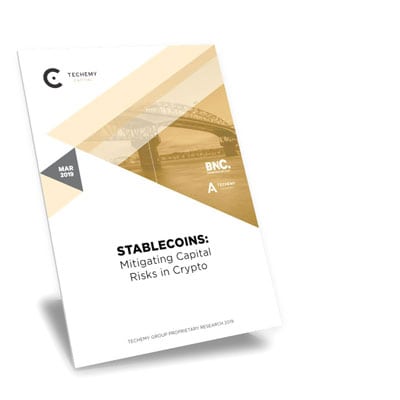Stablecoin economy set for continued growth
The stablecoin ecosystem is rapidly evolving — with banks, big tech, and crypto startups all clamoring to offer blockchain-based versions of fiat currencies.
Unlike other cryptocurrencies caught in the storms of volatility, stablecoins are pegged to real-world assets — from currencies to commodities — and came to the fore in 2018 by providing a welcome respite from the bear market that savaged bitcoin and other large-cap coins, and tokens alike.
In response, some commentators dubbed 2018 the year of the stablecoin. In 2019 the stablecoin ecosystem has continued to boom. Reputable coins with the backing of banks and third-party audits are starting to build a bridge between mainstream and digital finance.
As recent research by Tradeblock found, stablecoin on-chain transaction volumes are now starting to edge into the realm of legacy payment services. The study showed that across the largest stablecoins, total on-chain transfer volume has surpassed the total payment volume processed by Venmo — the mobile payment service owned by PayPal.
Elsewhere, other studies have revealed similar growth. Research from Binance in March found that stablecoins have grown to represent 26 percent of the total cryptocurrency market volume. The study suggests "increasing demand to manage the volatility inherent in other crypto assets" is responsible for stablecoins occupying a growing share of the crypto economy.
Choice in currency
As the stablecoin market expands, new coins are threatening to topple the dominance of the current market leader, Tether.
Though over two thirds of bitcoin trades are still made against Tether, the controversial market leader is gradually losing out to other dollar-pegged stablecoins like Paxos, TrueUSD, USD Coin and StableUSD. Tether fell from a 90 percent market share in September 2018 to around 65 percent in February 2019.
As the dominant global currency, the US dollar has attracted the lion’s share of stablecoins. But as the ecosystem evolves, other global currencies are attracting their own blockchain-based versions — each aiming to fill a niche in the crypto economy.
EURS, a fiat-collateralized version of the Euro launched in July, is built to comply with the regulations of crypto-friendly Malta and aims to help usher more European institutional investors into cryptocurrency.
The Universal Euro, launched in April by a group of six blockchain firms including Bittrex, is another fresh contender aimed at everyday users looking to hedge against the swings of bitcoin or enjoy eight percent interest rates by staking the coins through decentralized credit platform Cred.
More controversial is Tether’s new effort to tokenize the offshore Chinese yuan, which is expected to launch in the near future. CNHT, as the ticker reads, is supposedly designed to make Tether less dependent on the dollar for its stablecoin business, but could be a response to a keen appetite for Tether in China. DIAR discovered earlier this year that Chinese exchanges accounted for 39 percent of the on-chain transaction value for Tether, which is thought to be used to evade strict strict capital controls.
Tokenizing the yuan, however, could lead Tether to tread on the toes of the Chinese government.
The People’s Bank of China is the frontrunner among banks worldwide working on a Central Bank Digital Currency. The digital yuan has a political bent and is thought to be an economic defense strategy. Some have suggested that Tether’s innovation might be seen as an intrusion — and an attempt to dilute the government’s authority.
Along with governments and central banks minting stablecoins for political reasons,
and startups hoping to serve the demands of institutional investors, organizations in developing regions are using stablecoins to serve the unbanked.
UnionBank — the biggest bank of the Philippines — rolled out the peso stablecoin PHX in late July. This aims to serve the 70 percent of the population that doesn’t have access to banking services. PHX will theoretically allow families without access to banking services to receive international remittances sent from some 10 million Filipinos working overseas.
Last week Binance announced its plans to initiate an open blockchain project, Venus, an initiative to develop localized stablecoins and digital assets pegged to fiat currencies across the globe. Binance is looking to create new alliances and partnerships with governments, corporations, technology companies, and other cryptocurrency companies and projects involved in the larger blockchain ecosystem, to empower developed and developing countries to spur new currencies.
As security tokens proliferate over the coming years, we could see stablecoins become even more popular — used not just for remittance, crypto trading, and as a store of value, but as a vehicle for accessing new breeds of investment.
DOWNLOAD FREE REPORT
STABLECOINS: Mitigating Capital Risks in Crypto
With many new entrants, the stablecoin market is currently in an exploratory phase, with no single stability mechanism available that satisfies all the requirements of potential stakeholders. Download this groundbreaking Techemy Capital report now to access compelling new insights into this critical sector and its likely long term evolution.

Don’t miss out – Find out more today




